Wednesday, September 24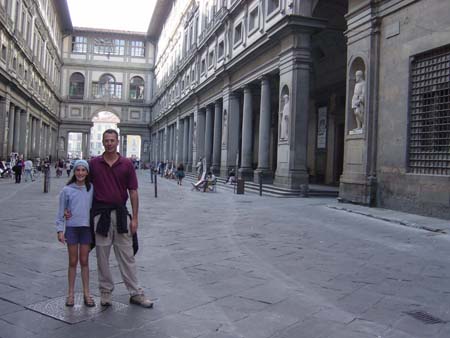
Steve and Paula: Today we spent exploring much more of the art and architecture of Florence. We created a very ambition plan for day and with Freya's help, we were able to accomplish most of what we had hoped. Knowing that the Uffizi Gallery fills up quickly, we got an early start and decided to make this our first stop.
The Uffizi was originally the office for the Medici Family and contains works
of art commissioned by the Medici's over the 300 years that they essentially
ruled Florence. The museum's exhibits are arranged in chronological order
starting with the 1300s in Italy, through the Renaissance, and moving into
the 18th century. Botticelli's Birth of Venus and Primavera are two of the
best-known masterpieces in the Uffizi, and are spectacular. Thes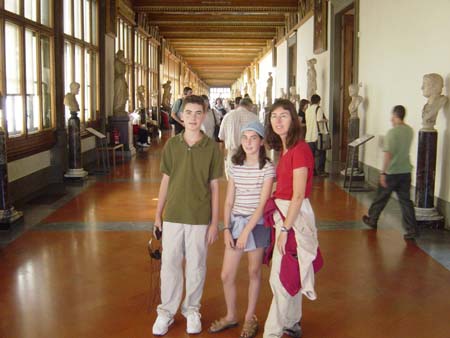 e
were painted during the height of Botticelli's career, and are well-known
for their brilliant colors and compositions. We also enjoyed other masterpieces
by Raphael, Giotto and Michelangelo. The Uffizi is a wonderful museum, and
is easy to understand and navigate. We thoroughly enjoyed our time at Uffizi
(even David agreed that this was something special!).
e
were painted during the height of Botticelli's career, and are well-known
for their brilliant colors and compositions. We also enjoyed other masterpieces
by Raphael, Giotto and Michelangelo. The Uffizi is a wonderful museum, and
is easy to understand and navigate. We thoroughly enjoyed our time at Uffizi
(even David agreed that this was something special!). 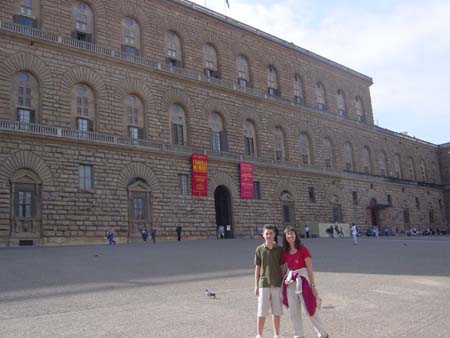
Our next stop was the Pitti Palace. We had visited the Boboli Gardens last
week, but wanted to return today to see the Palatine Gallery and Royal Apartments
of the Medicis. We were not prepared for the huge collection of magnificent
art contained in the Medici's private collection (there are over 1,000 paintings
here, including the Madonna of the Chair by Raphael, and Mary Magdalene by
Titian). The walls of the Palatine Gallery are literally filled with paintings
and they hang today just as the Medicis had arranged them. The sheer number
of paintings is overwhelming, and it's very difficult to focus on any one
work or masterpiece. The apartments are exactly as they were left in the 1780s
with the furniture, draperies, artwork and decorations all being original.
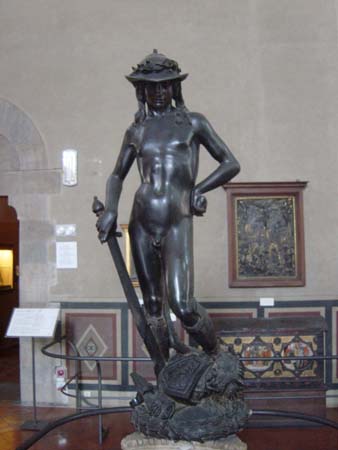
After a quick lunch, we met Freya at the Bargello Museum. The Bargello was
Florence's original town hall from the 1200s. It was also a police station
and a prison before becoming a museum. The Bargello is often overlooked by
visitors to Florence because it focuses on sculptures rather than paintings.
This is one of Freya's favorite museums, and we were definitely delighted
by its treasures. The highlights of the Bargello include sculptures by Donatello
(the first true Renaissance sculptor) and the bronze panels depicting the
Sacrifice of Isaac submitted by Brunelleschi and Ghiberti in the competition
to produce the third set of Baptistery doors. We especially enjoyed comparing
and contrasting these panels, and hearing Freya's perspectives on why Ghiberti's
submission was superior (we agreed!). Freya also told us several wonderful
stories about the sculptures in the museum, especially Dontatello's David.
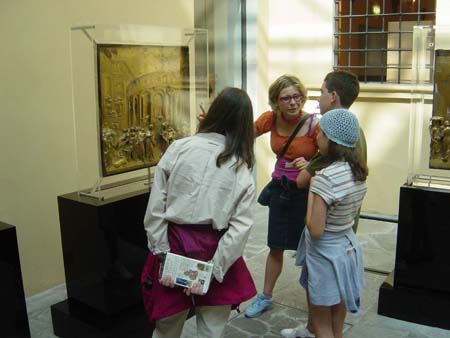
From the Bargello we walked to the Museum dell'Opera, which houses items
removed for protection primarily from the exterior of the Duomo. This is a
beautiful museum, and it contains several treasures including the original
panels from Ghiberti's Baptistry doors. It was wonderful to be able to examine
these panels up close, and it was amazing to see how Ghiberti created such
a sense of depth on panels that actually were very thin. The dell'Opera also
contains Michelangelo's last Pieta, which 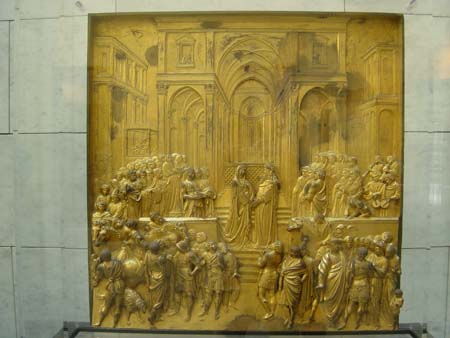 has
a very interesting story attached to it. When the sculpture was almost finished,
Michelangelo decided that he didn't like the work (or the block of marble
that was being used), and he began to physically destroy it. The Pieta was
eventually acquired by a collector who attempted to restore it, but it is
obvious today where the damage was done. We also enjoyed seeing and learning
about several sculptures (by Donatello and others), two
has
a very interesting story attached to it. When the sculpture was almost finished,
Michelangelo decided that he didn't like the work (or the block of marble
that was being used), and he began to physically destroy it. The Pieta was
eventually acquired by a collector who attempted to restore it, but it is
obvious today where the damage was done. We also enjoyed seeing and learning
about several sculptures (by Donatello and others), two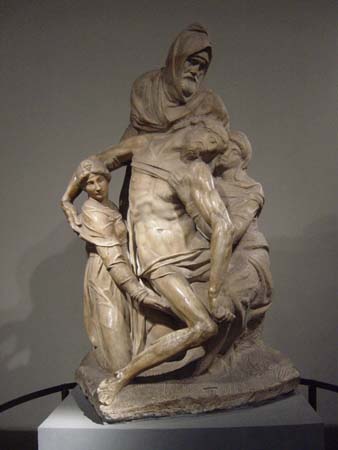 singing galleries (created by Donatello and Luca della Robbia) that were removed
in the 1600's, and several exhibits about the construction of Bruelleschi's
dome.
singing galleries (created by Donatello and Luca della Robbia) that were removed
in the 1600's, and several exhibits about the construction of Bruelleschi's
dome.
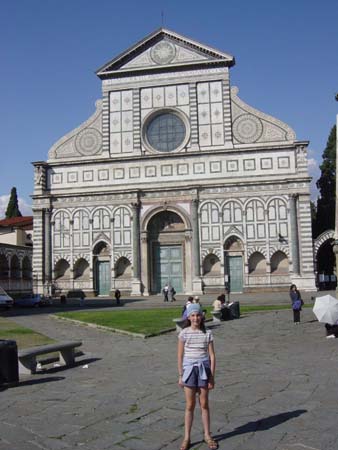 Our
next stop was the Santa Maria Novella, a Dominican church from the 1200s.
The façade of the Santa Maria Novella is classic Renaissance architecture.
Inside, the church feels large and open (similar to the Santa Croce), but
has a warmer feeling to it. We enjoyed learning about The Trinity, a very
famous fresco by Masaccio (considered to be the first true Renaissance painter,
but not well known). In addition, there are wonderful frescoes behind the
altar - these were painted by Ghirlandaio and cover the lives of John the
Baptist (the patron saint of Florence) and the Virgin Mary. We learned that
Michelangelo worked as an apprentice on these frescoes, and this was where
he first learned this art form.
Our
next stop was the Santa Maria Novella, a Dominican church from the 1200s.
The façade of the Santa Maria Novella is classic Renaissance architecture.
Inside, the church feels large and open (similar to the Santa Croce), but
has a warmer feeling to it. We enjoyed learning about The Trinity, a very
famous fresco by Masaccio (considered to be the first true Renaissance painter,
but not well known). In addition, there are wonderful frescoes behind the
altar - these were painted by Ghirlandaio and cover the lives of John the
Baptist (the patron saint of Florence) and the Virgin Mary. We learned that
Michelangelo worked as an apprentice on these frescoes, and this was where
he first learned this art form.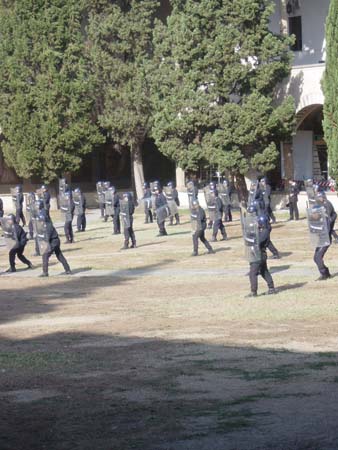
Freya then took us to a pharmacy actually created in the 1400's by the Dominican
Monks to sell healing rose water. The pharmacy still operates today, and sells
all kinds of healing products - it's housed in a beautiful building. Interestingly,
the pharmacy looks out on a courtyard which is used in the training of Italian
military police. When we arrived, a group of rookie recruits was practicing
riot control methods using shields and batons. It was fun to watch, and very
amusing to see among the original frescoes and buildings of the Dominican
monks. 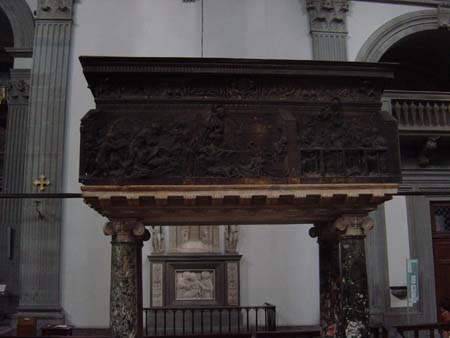
Our last stop with Freya was the church of San Lorenzo. This was the Medici's parish church, and contains beautiful pulpits created by Donatello, and a Mannerist-style fresco by Bronzino.
We then said goodbye to Freya, and walked to the Galleria del'Accademia.
This museum was created specifically to house the original copy of Michelangelo's
David, which had been damaged several times in its original location outside
the Town Hall. It was fun to see David again, and its size and realistic qualities
are truly impressive. Unfortunately, a major restoration effort began on September
1 (scheduled to continue into 2004), so we had to view David along with some
scaffolding. We also enjoyed seeing Michelangelo's four prisoners, sculptures
depicting muscular 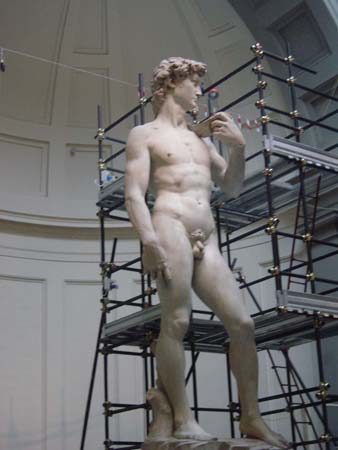 figures
struggling to free themselves from stone.
figures
struggling to free themselves from stone.
Today was a great and very educational day for us all. With Freya's help,
we learned a tremendous amount about specific works of art, the lives of Italian
artists and several interesting dynamics a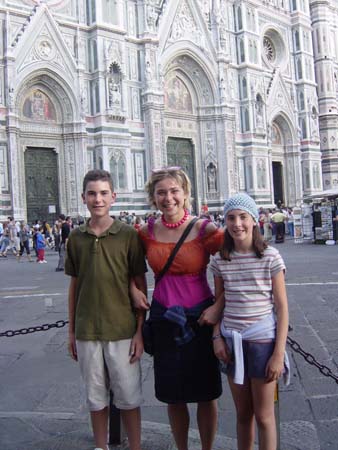 bout
Florence's Renaissance movement. For example, Freya explained how Giorgio
Vasari's book, Lives of the Artists, has had such a huge impact on how we
view who the true Renaissance masters truly were. It is now believed that
there were many other equally accomplished Renaissance artists outside of
Florence, but Vasari wanted specifically to promote Florentine artists. It
was also interesting to learn about how Renaissance artists operated. These
artists all had large workshops, and the work was actually performed by groups
of artists under the supervision of the lead artist (e.g. Raphael, Botticelli).
However, in our minds we normally picture an individual artist as having produced
their masterpieces independently.. Freya told us that there's even some controversy
regarding whether Michelangelo painted the Sistine Chapel on his own.
bout
Florence's Renaissance movement. For example, Freya explained how Giorgio
Vasari's book, Lives of the Artists, has had such a huge impact on how we
view who the true Renaissance masters truly were. It is now believed that
there were many other equally accomplished Renaissance artists outside of
Florence, but Vasari wanted specifically to promote Florentine artists. It
was also interesting to learn about how Renaissance artists operated. These
artists all had large workshops, and the work was actually performed by groups
of artists under the supervision of the lead artist (e.g. Raphael, Botticelli).
However, in our minds we normally picture an individual artist as having produced
their masterpieces independently.. Freya told us that there's even some controversy
regarding whether Michelangelo painted the Sistine Chapel on his own.
UNESCO estimates that 45% of the world's greatest art resides in Italy, and that 60% of this art is here in Florence. Today was a wonderful opportunity for us to see and learn about much of this art.
Tomorrow, we are again planning to spend the day with Roberta to explore several towns in the Southern Tuscany, including Montalcino and Pienza.
Distance Walked: 5.75 miles
